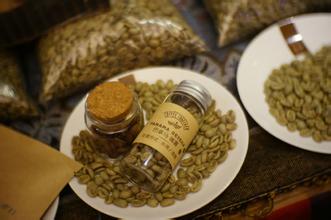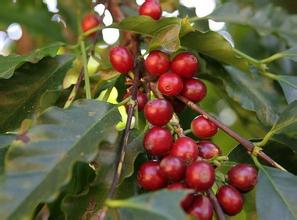The latest introduction of high-quality coffee raw beans
Raw coffee beans are the seeds of coffee trees. It is the wealth hidden in coffee cherries (coffee berries) that people usually call coffee cherries. They are mistakenly called "beans" because they are similar to the beans we usually see, but they are actually the seeds of coffee. Usually there are two flat oval coffee beans in the coffee berries, and a small number of coffee berries contain only one coffee raw bean, just like there is only one grain of rice in the rice. This kind of bean is called Peaberry. These raw coffee beans usually contain endosperm.
The spread of coffee beans originated in Ethiopia, about 850 in the Christian era. It then spread throughout the Arabian Peninsula, and coffee was not really documented until the 900th year of the Christian era. At that time, the Yemenis carefully guarded the coffee in order to prohibit the outflow of coffee. However, some coffee saplings are smuggled to the Netherlands and planted in greenhouses.
Coffee trees can usually grow up to 5-10 meters tall. The older the coffee tree is, the fewer branches it will have, but the more leaves and fruits it will have. Coffee trees usually begin to bear fruit three to four years after planting. The number of years in which coffee trees produce fruit varies from 10 to 20 years, depending on the region and tree species planted.
Coffee trees are usually planted in rows a few inches apart. Some coffee farmers grow coffee under other high cash crops, or on the other side of the mountain, because coffee requires a specific growing environment. Arabica coffee trees can only grow at 15-24 ℃, while Robusta coffee trees can grow at 30 ℃. The average annual rainfall is 150-300mm. In the fruit growth stage, a large amount of rainfall is conducive to growth, but in the fruit ripening stage, a small amount of rainfall is better. Because the climate in the northern and southern hemispheres is different, the harvest time of coffee beans is also different. In some places, coffee beans are harvested all the year round.

Important Notice :
前街咖啡 FrontStreet Coffee has moved to new addredd:
FrontStreet Coffee Address: 315,Donghua East Road,GuangZhou
Tel:020 38364473
- Prev

Rosa coffee boutique coffee bean flavor unique flower aroma, tropical fruit, strong sweetness
In 1931, he obscure exported Kenya from Geisha Mountain Mountain in southwestern Ethiopia to Tanzania and Costa Rica, then transplanted to Panama in the 1960s, and then went through nearly half a century before he became a blockbuster, defeating the victorious armies such as Bourbon, Kaddura, Kaduai, Tibica and so on, winning 2005 in one breath.
- Next

Indonesia Manning Coffee latest Coffee introduction and details
Indonesian Manning coffee is rich and solid in taste and has a pleasant sour taste. The smell is mellow, the acidity is moderate, the sweetness is rich and very intriguing, it is suitable for deep baking and exudes a strong aroma. The gentleman in coffee-- Sumatra Manning Manning is a first-class coffee bean grown in the plateau and mountain area at an altitude of 750-1500 meters above sea level. It is produced by Takengon and Sidikalang.
Related
- Detailed explanation of Jadeite planting Land in Panamanian Jadeite Manor introduction to the grading system of Jadeite competitive bidding, Red bid, Green bid and Rose Summer
- Story of Coffee planting in Brenka region of Costa Rica Stonehenge Manor anaerobic heavy honey treatment of flavor mouth
- What's on the barrel of Blue Mountain Coffee beans?
- Can American coffee also pull flowers? How to use hot American style to pull out a good-looking pattern?
- Can you make a cold extract with coffee beans? What is the right proportion for cold-extracted coffee formula?
- Indonesian PWN Gold Mandrine Coffee Origin Features Flavor How to Chong? Mandolin coffee is American.
- A brief introduction to the flavor characteristics of Brazilian yellow bourbon coffee beans
- What is the effect of different water quality on the flavor of cold-extracted coffee? What kind of water is best for brewing coffee?
- Why do you think of Rose Summer whenever you mention Panamanian coffee?
- Introduction to the characteristics of authentic blue mountain coffee bean producing areas? What is the CIB Coffee Authority in Jamaica?

